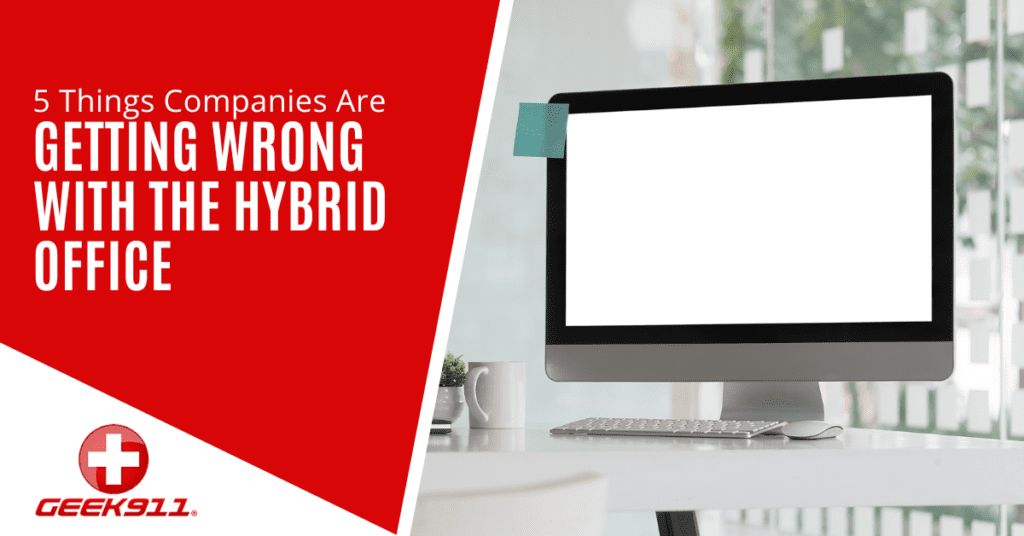5 Things Companies Are Getting Wrong with the Hybrid Office

The hybrid work structure is the future of most organizations and companies as these business enterprises are still trying to pan out different ways to grow while retaining, maintaining, and engaging their staff.
Unfortunately, companies are getting some hybrid practices wrong with assumptions and office cultures. They haven’t got the hang of practical ways to bring back their employees, which is vital in creating a suitable and balanced hybrid structure and experience.
Lots of examples are available where organizations have set a date for their employees to return to work, but nearly half of them showed up. Most of these companies had to either fire their staff or compel them to bring them back without nipping internal issues in the bud. Furthermore, statistics show that about 63% of employees assert that their respective companies do not upgrade their workplace to suit the new working style, hybrid.
However, in this article, you will get to understand the various things companies are getting wrong with the hybrid work structure.
The Wrong Decisions Companies Make While Creating a Hybrid Structure
Below are the things companies get wrong while creating the hybrid structure for their workplaces:
Taking the importance of Mindset for granted
In the process of rushing to create procedures and policies, a lot of leaders often overlook the significance of human mindsets and needs in proportion to the hybrid work structure. For example, the hybrid work structure can be perceived as an opportunity to boost high performance by having the whole person in mind, instead of just seeing it as a mixture of working from home and in the office.
With this frame of mind, leaders can bring out the best office and home environments to form new means of working structures that increase performance, resilience, and culture. Leaders are hereby encouraged to check in more on their employees, reduce virtual meetings and utilize more physical office time.
Having the knack for the hybrid work structure can’t be found in a specific process; instead, having the right mindset and examining how the hybrid structure works can drive the business to its peak.
Old fashioned practices
The biggest mistake some managers make is the continuous application of the “brick and mortar” administration practices to a hybrid work structure. In some cases, some managers are not adequately equipped to run the hybrid workforce, and they usually fall back to the old-fashioned methods of “if you are not physically present, you aren’t working.”
Firms need to prepare better to equip their managers and staff with effective and efficient training sessions to increase productivity in the hybrid workforce. Having a flexible virtual work structure with coffee breaks and flexible staff schedules rather than a strict one-way structure are just some ways to better motivate, engage and positively influence your hybrid workforce.
Now is the perfect moment to revoke old business practices and create practical, innovative approaches in your hybrid workforce.
Not everything goes
The Hybrid work structure has the necessary potential to meet the needs of the employees in terms of their well-being and safety. If it is carried out correctly, they can become the impeccable balance of productivity, collaboration, flexibility, and inclusiveness.
Where the hybrid work environment goes off beam is the process of taking an “anything goes” attitude. Lacking the outline of how and when employees work and relate, some of them will be left out of decisions, conversations, and opportunities.
Managers can help push the organization to a more developed schedule, structures, feedback, and norms that are required to make the in-office and the virtual environment efficient. Following this technique gives your hybrid work environment the chance to thrive.
Managing staff performance
Hybrid workstations are struggling to manage their employees’ performance. Quite a range of companies was coerced to swiftly switch to the remote environment in the year 2020 because of the outbreak of the pandemic. In most cases, firms missed certain vital steps such as stating clear expectations for workers that are working remotely and staging up performance measures for remote employees that are keen on success.
Administrators ought to engage their team to set specific/clear objectives while working remotely and physically and provide essential and timely feedback about their performance as regards the company’s goals and aims.
Company cultures
A hybrid work environment is an effective way to get more talent when done right. All you have to do is provide flexible schedules for your staff and continually build a happy and productive team.
However, the issue is that companies do not provide remote staff with an exciting and unique onboarding experience like the on-site staff. Over time, it results in creating two working cultures instead of one. This way, you have successfully created a division amongst your employees, which will definitely hinder your business growth and productivity.
Choose the Right Technology for Your Hybrid Office
At GEEK911, we are experts at optimizing the modern office. This includes on-site setups, remote teams, and mixes of both.
We have quite a range of resources available for you at a pocket-friendly cost. Contact us online or at (866) 433-5411 today to discuss your digital workplace challenges.
